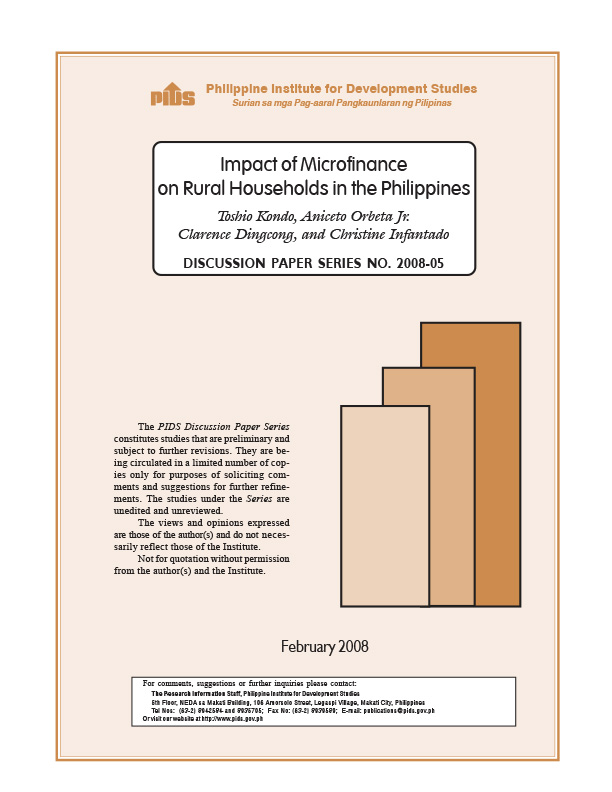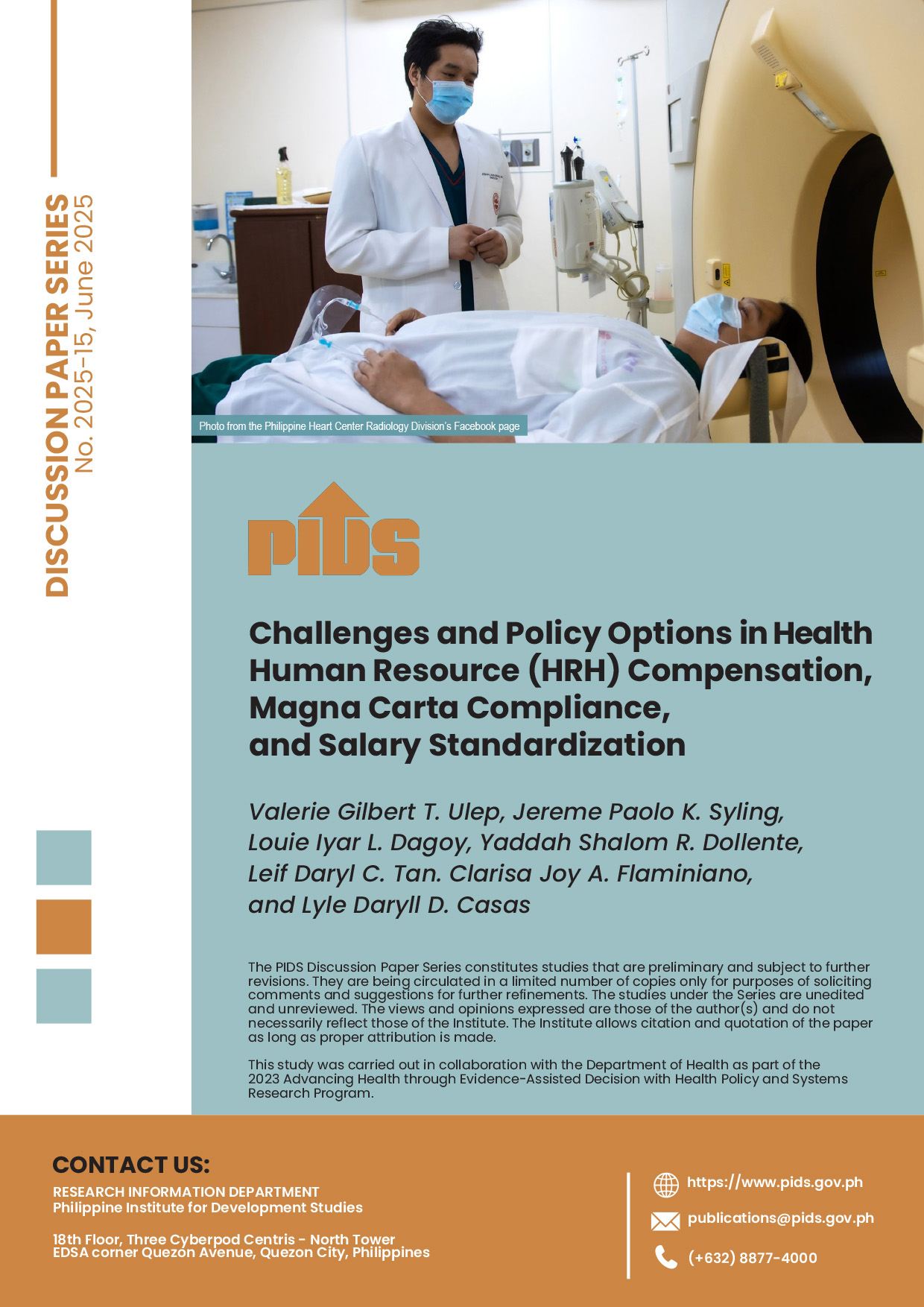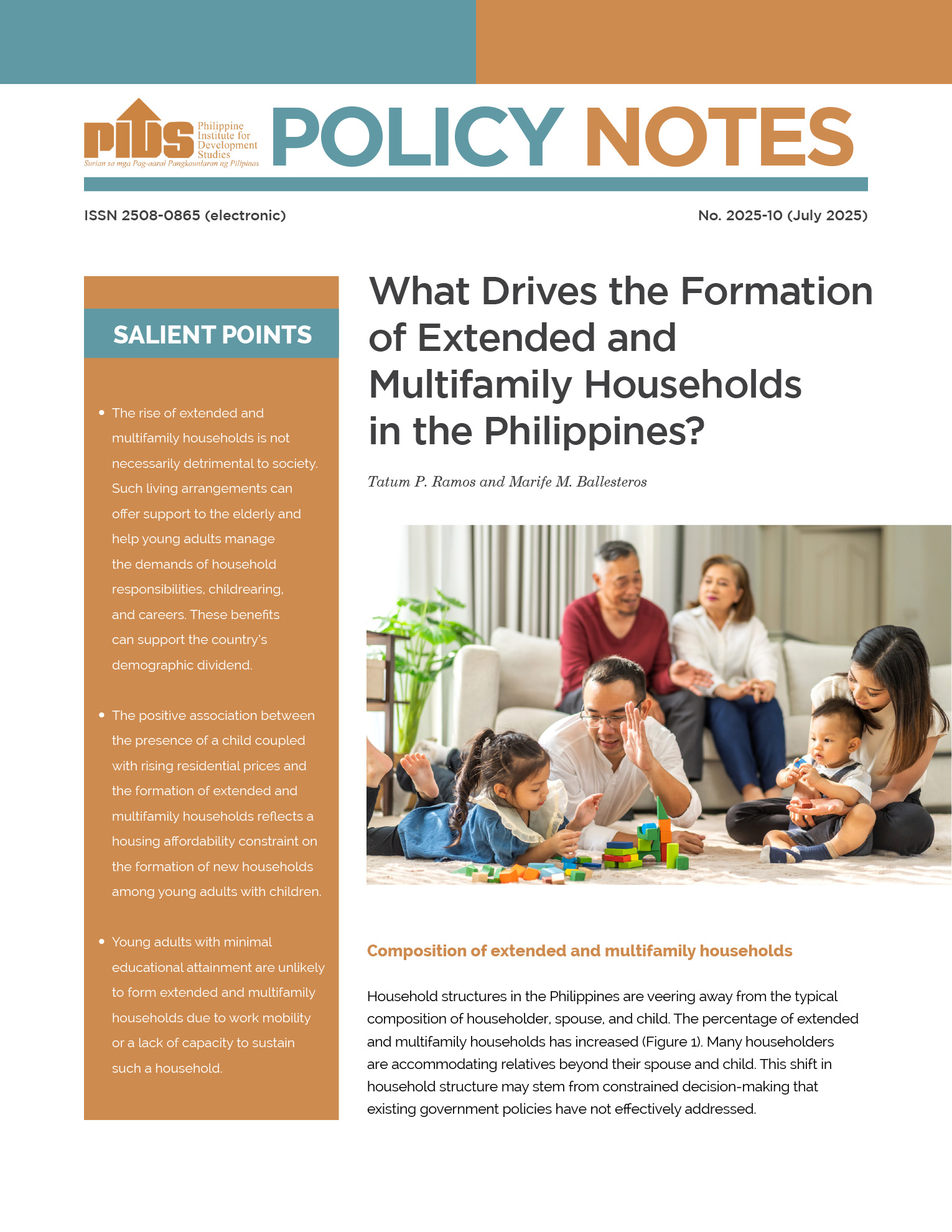This paper reports on the impact evaluation study of the Rural Microenterprise Finance Project (RMFP) in the Philippines. RMFP aimed to support efforts of the Government of the Philippines to strengthen rural financial institutions by assisting organizations that employed the Grameen Bank Approach (GBA) in providing credit to the poor. The project was implemented by the People’s Credit and Finance Corporation (PCFC) and funded by the Asian Development Bank. The evaluation uses a quasi-experimental design with incoming clients of randomly selected participating microfinance institutions as the comparison group. An important innovation in the study is the inclusion of the appropriate number of former clients among the treatment group. Qualified nonparticipating households provide the control for area effects. The impact estimation uses the difference-in-difference estimation technique which effectively controls for the known sources of biases namely: nonrandom program participation (sample selection), nonrandom program placement, and nonrandom drop-out. The results led the authors to recommend that for microfinance programs to be effective as a poverty-alleviation tool there is a need to review and constantly monitor the effectiveness of the targeting procedures. In addition, it was pointed out that there may be a need to assist the poor in selecting appropriate projects that not only ensure loan repayment but also generate ample profit as well.
Citations
This publication has been cited 24 times
- Akotey, Joseph Oscar and Charles K.D. Adjasi. 2016. Does microcredit increase household welfare in the absence of microinsurance?. World Development, 77(C), 380-394. Elsevier.
- Bensch, Gunther, Jochen Kluve, and Jörg Peters. 2011. Impacts of rural electrification in Rwanda. Journal of Development Effectiveness, 3, no. 4, pages 567-588. Taylor & Francis Journals.
- Bensch, Gunther, Jochen Kluve, and Jörg Peters. 2011. Impacts of rural electrification in Rwanda. Ruhr Economic Papers 284. RWI - Leibniz-Institut für Wirtschaftsforschung, Ruhr-University Bochum, TU Dortmund University, University of Duisburg-Essen.
- Bensch, Gunther, Jochen Kluve, and Jörg Peters. 2011. Impacts of rural electrification in Rwanda. IZA Discussion Papers 6195. Institute of Labor Economics (IZA).
- Bensch, Gunther, Jörg Peters, and Christoph M. Schmidt. 2012. Impact evaluation of productive use - An implementation guideline for electrification projects. EconStor Open Access Articles and Book Chapters, ZBW, 186-195. Leibniz Information Centre for Economics.
- Bensch, Gunther, Jörg Peters, and Christoph M. Schmidt. 2011. Impact evaluation of productive use – An implementation guideline for electrification projects. Ruhr Economic Papers 279, RWI. Leibniz-Institut für Wirtschaftsforschung, Ruhr-University Bochum, TU Dortmund University, University of Duisburg-Essen.
- Bensch, Gunther, Jörg Peters&, and Christoph M. Schmidt. 2012. Impact evaluation of productive use—An implementation guideline for electrification projects. Energy Policy, 40(C), 186-195. Elsevier.
- Donou-Adonsou, Ficawoyi and Kevin Sylwester. 2017. Growth effect of banks and microfinance: Evidence from developing countries. The Quarterly Review of Economics and Finance, 64(C), 44-56 . Elsevier.
- Fianto, Bayu Arie. 2018. Equity financing and debt-based financing: Evidence from Islamic microfinance institutions in Indonesia. Pacific-Basin Finance Journal, 52(C), 163-172 . Elsevier.
- Gagandeep Kaur Gill. 2014. Microfinance and poor: A case study of district Sangrur. International Journal of Regional Development, 1, no. 1, 79-87. Macrothink Institute.
- Grimm, Michael and Anna Luisa Paffhausen. 2014. Do interventions targeted at micro-entrepreneurs and small and medium-sized firms create jobs? A systematic review of the evidence for low and middle income countries. IZA Discussion Papers 8193. Institute of Labor Economics (IZA).
- Grimm, Michael and Anna Luisa Paffhausen. 2015. Do interventions targeted at micro-entrepreneurs and small and medium-sized firms create jobs? A systematic review of the evidence for low and middle income countries. Labour Economics, 32(C), 67-85. Elsevier.
- Jia, Xiangping et. al. 2016. Commercialization and mission drift: Evidence from a large Chinese microfinance institution. China Economic Review, 40(C), 17-32 . Elsevier.
- Jia, Xiangping et. al. 2016. Commercialization and mission drift: Evidence from a large Chinese microfinance institution. Policy Research Working Paper Series 7680. The World Bank.
- Jimi, Nusrat Abedin et. al. 2018. the effects of access to credit on productivity: Separating technological changes from changes in technical efficiency. Working Papers 2019-052. Human Capital and Economic Opportunity Working Group.
- Jimi, Nusrat Abedin et. al. 2019. the effects of access to credit on productivity: Separating technological changes from changes in technical efficiency. IZA Discussion Papers 12514. Institute of Labor Economics (IZA).
- Kono, Hisaki and Kazushi Takahashi. 2010. Microfinance revolution: Its effects, innovations, and challenges. The Developing Economies, 48, no. 1, 15-73 . Institute of Developing Economies.
- Luan, Hao, Xiangping Jia, and Jikun Huang. 2014. Household access to nongovernmental microfinance, formal credit and informal credit in rural China. Review of Economics & Finance, 4, pages 61-76, May. Better Advances Press, Canada.
- Maîtrot, Mathilde and Miguel Niño-Zarazúa. 2017. Poverty and wellbeing impacts of microfinance: What do we know?. WIDER Working Paper Series wp-2017-190. World Institute for Development Economic Research (UNU-WIDER).
- Malek, Mohammad Abdul et. al. 2019. The effects of access to credit on productivity: Separating technological changes from changes in technical efficiency. Natural Field Experiments 00709. The Field Experiments Website.
- Nusrat Abedin Jimi et. al. 2019. The effects of access to credit on productivity: Separating technological changes from changes in technical efficiency. Journal of Productivity Analysis, 52, no. 1, 37-55. Springer.
- Nusrat Abedin Jimi et. al. 2020. The effects of access to credit on productivity among microenterprises: Separating technological changes from changes in technical efficiency. Papers 2006.03650. arXiv.org.
- Peters, Jörg. 2009. Evaluating rural electrification projects - methodological approaches. Ruhr Economic Papers 136. RWI - Leibniz-Institut für Wirtschaftsforschung, Ruhr-University Bochum, TU Dortmund University, University of Duisburg-Essen.
- Rajbanshi, Ram, Meng Huang, and Bruce Wydick. 2015. Measuring microfinance: Assessing the conflict between practitioners and researchers with evidence from Nepal. World Development, 68(C) 30-47. Elsevier.













